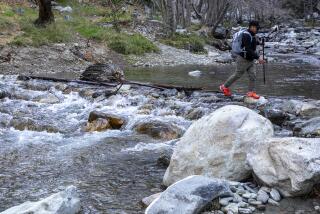Summer Special : ON THE WILD SIDE : Blazing the County’s Many Trails Gives Look Behind Streets, Suburbs
- Share via
Once a week or so, runner Marcia Martyn fills two empty Aunt Jemima syrup bottles with water, dons a white cotton cap and heads for the hills.
There, Martyn, a 49-year-old special education teacher from Corona del Mar, finds what many distance runners often seek:
Miles of soft, dirt trails that twist and dip under shady oaks. Challenging climbs--and thrilling decents--along cattle-worn paths. Glimpses of rabbits, skunks or bobcats darting through the thick brush.
Call it distance runners’ nirvana or just a good workout. More Orange County runners are leaving the streets for the hills in search of happy trails.
“Trails are just so much more fun than the roads,” said Martyn, who started running nine years ago in celebration of her 40th birthday.
“The varied terrain, the surroundings . . . it makes it all so much more interesting. And that helps keeps your mind off the fact that you’re working hard.”
Orange County, and its outlying areas, has an abundance of trails. There are the ocean-view paths of Crystal Cove State Park. The rugged wilderness of the Cleveland National Forest. The partly wood-chipped bridle trails in central Fullerton.
Many runners travel outside the county to more mountainous regions: the Angeles Crest Highway area, the San Bernardino and San Gorgonio mountains, the Eastern Sierras . . .
Wherever you run them, trails offer runners many advantages. The challenging terrain develops both cardiovascular and muscular strength. The soft, dirt trails are gentle on the knees, legs and feet.
And eye-foot coordination quickly develops as the runner learns to hop and bound over unexpected surprises--boulders, shrubs, even snakes.
But mostly, runners say, trails provide a sense of space and freedom that paved roads so rarely offer.
“It’s just a real pleasure,” Fred Shufflebarger, a longtime trail runner from Laguna Beach, said. “Running over broken terrain, it’s almost a gymnastic type of thing. The undulating road, dipping and darting and jumping over things. . . . When it’s you against the trail, there’s a real sense of satisfaction. And a grander feeling of accomplishment.”
But, experts warn, beginners should do their first dipping and darting with caution.
Fred Pilon, publisher of Ultrarunning magazine in Sunderland, Mass., has run thousands of miles of rugged trails throughout the United States. He warns that serious trail running is more than a simple skip through the park.
“I know a lot of road runners who go out on the trails the first time and end up bashing their knees or their foreheads, falling all over the place,” Pilon said.
“The beginning trail runner really has to develop trail-running skills. Most beginners have a tendency to stare down at their feet. Because of that, they’re much more prone to turning their ankles. They don’t realize they need to pick their heads up, look ahead, and just let their brains take over.
“The legs will do the work if you let your brain take care of the balance.”
Veteran trail runners also advise that beginners make sure they know exactly where the trail runs.
Herb Tanzer, who won the 100-mile Western States Endurance Run in 1987, suggests talking with other runners or park rangers who know the area.
“You really have to scope the trail out first or you’ll get lost,” Tanzer, 36, of Topanga, said. “Get a trail map, or go to your local running store and talk to people who’ve run the trail. You want to know what you’re getting into before you get into it.”
One of the most serious concerns for trail runners, experts say, is avoiding dehydration. Especially when runs can go for hours across areas where no drinking water can be found.
“Proper hydration is incredibly important for those who are just starting,” Tanzer said. “It’s amazing how fast you dehydrate. You need to plan your runs around the nearest watering holes. If there aren’t any, go to a local bike store and buy a couple water bottles.”
Or, check out your cupboards.
“Aunt Jemima bottles are perfect because the handles fit just right in your hands as you run,” Martyn said. “I prefer the 12-ounce size myself.”
Wildlife also can be of great concern to trail runners. Though animals most-often encountered--rabbits, squirrels, mule deer--are hardly considered dangerous, there have been problems with other species, namely mountain lions and rattlesnakes.
In Ronald W. Caspers Wilderness Park in San Juan Capistrano, two children were mauled by mountain lions two years ago. Because of this, trails are open only to runners 18 and over.
According to park ranger Jude Weierman, visitors must travel in groups of two or more, and must sign a permit saying they are informed of the mountain lions and rattlesnakes in the area.
“We haven’t had a mountain lion sighting for a long time,” Weierman said. “But we encourage everyone to stay on the trails and practice caution anyway.”
That, of course, is a valuable guideline on any trail. Common sense--running in groups, being alert, and carrying enough water--will help make any trail-running experience more enjoyable.
“Once you get into it, trail running is a joy, really,” Shufflebarger said. “Sometimes, it’s tough for me to get motivated enough to do a seven- or eight-miler on the roads.
“But if someone calls and says, ‘Hey, let’s get up tomorrow morning and run that 27-miler on the trails’, I say, ‘Yeaaaaah. ‘ “
More to Read
Sign up for The Wild
We’ll help you find the best places to hike, bike and run, as well as the perfect silent spots for meditation and yoga.
You may occasionally receive promotional content from the Los Angeles Times.






